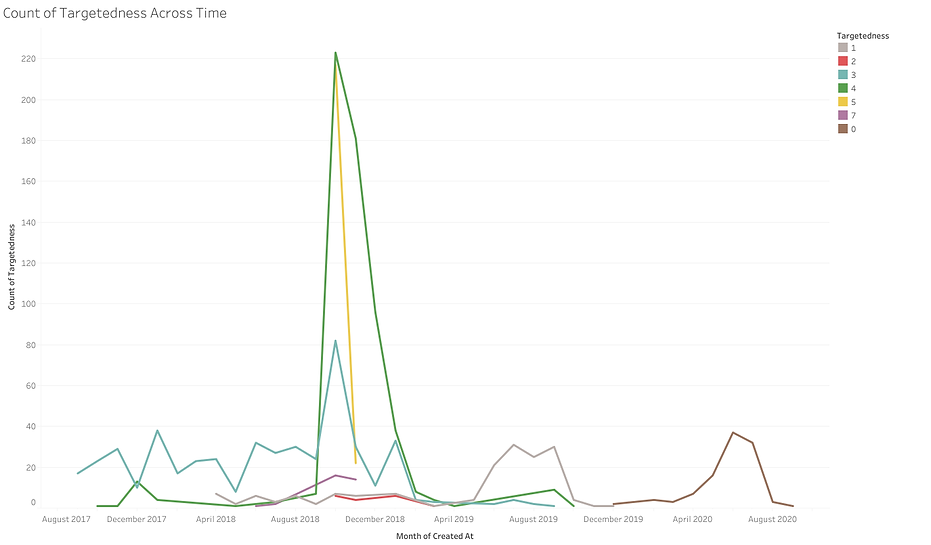
Exploratory Qualitative Analysis


The overarching messaging strategy of Trump's Facebook advertisements is to position Trump as the provider of safety while any opponent is a source of insecurity or fear. The messages suggest that the opposition (Democrats, Nancy Pelosi, Chuck Schumer, Hillary, etc.) are trying to damage the security of the nation's security. Each message is designed to induce a sense of fear of an invading force bent on destabilizing the US.
One of Trump's message even goes so far as to say that no one else will fight this battle for them. For advertisements that contain the word "Democrat", the tone is even more antagonistic and combative with the most common messages containing words like "fight back", angry, RAGE, and seize. Messages that do not mention an opposition always include a promise for safety. For example, making America great, having the border wall be built, and improving the economy.
Content Analysis by Year
Throughout the Trump administration, the contents of their FB political ads have changed and adapted to the needs of their political agenda.
2017:
These ads are mostly engaging with FB users by asking them to partake in their "Mainstream Media Accountability Survey". While this message may seem benign on face value, it needs to be understood in the context of the messages broadcasted by his press briefings where the credibility and integrity of the inquiring journalist are constantly belittled.
2018:
The frequency of Trump originated FB advertisements skyrocket during 2018. The new major theme is to provide supportive messaging to the Republican 2018 midterm elections. Belittlement of the Mainstream Media institutions continue throughout 2018, as well as the new inclusion of an "Official Presidential Job Performance Survey".
2019:
Issues that continue to be broadcasted by their FB messaging campaign are the "Media Accountability Survey" and the beratement of mainstream media by calling them the "Fake News Media". A new survey is now being distributed to gauge his supporter's opinions on how they feel about Alexandria Ocasio-Cortez and Ilhan Omar, and their supposedly big government socialists like agendas.
2020:
Strangely, after 2018 and its midterm elections, the frequency of messages received by the Trump public relations entity have sharply declined. A continuing theme are that the messages ask for statements of support for president Trump and to respond to a weekly "Trump Approval Poll".
FB ads about the 2020 presidential election and Trump's opponent Joe Biden are new messages. They are designed to trigger fear reactions that shake the reader's sense of security by accusing Joe Biden of wanting to "defund the police" and permitting violent crime. Populist rhetoric is also becoming a common theme by associating the Fake News Media with the Democratic Elite which gives the audience the impression that the elites are constantly lying to them.
There are also direct attacks on Joe Biden by mentioning his age and suggesting that he lacks the strength, stamina, and mental fortitude required as a president. A nickname "Sleepy Joe" is attributed to his opponent to suggest that he lacks vitality.




Most Distributed FB Ad Messages

Exploratory Quantitative Analysis

The frequency of Facebook political advertisements peaked during the 2018 midterm elections. Interestingly enough, this pattern was not found again during the 2020 presidential election where Trump himself was running for President again.

ProPublica definition of Targetedness:
"an internal metric for estimating how granularly an ad is targeted, used for sorting in the ProPublica search interface"
The application of targeted FB political advertisements is used heavily before and during the midterm 2018 elections and abruptly declines afterwards. Again, note the lack of targetedness during the 2020 presidential elections. It is possible that the Trump campaign manager elected to use a different strategy or was removed from his/her position of responsibility. A possible reason for the abandonment of targeted messaging may be the poor showing of midterm elections by Republicans. Faith in the efficacy of this messaging methodology declined rapidly.
This chart shows the amount of targeting intensity across time. During the 2018 midterm elections, most messages had a targetedness rating of 4 and 5.
_pn.png)

Facebook interests that were selected for targeted messaging are very focused on those that have already liked Donald Trump. The Republican party is the next more frequently used message target, but all other interests are not used frequently.
It should be noted that it's possible the data collection method has a very heavy bias, because only those that choose to download the add-on will provide data. Those that aren't internet-savvy or are of the older generation may not be included at all. Even though they do use Facebook often.

This chart describes the involvement of "Audience Owner" entities like the DataTrust Client Services LLC which is described as,
"...provides high quality data sets to center-right campaigns, political parties, and other political committees..."
What is interesting about this chart is that the majority of their recorded behavior happens from June to July 2020. Considering that large actions in previous charts show large activity during the 2018 midterms, this chart may be an indicator of the Trump campaign manager exploring alternative messaging strategies to either replace or complement their current methodology.
Note: Data Trust and DT Client Services LLC are very likely the same entity.

This graph shows us the number of messages that were targeting the country regions. The meaning of "region" within the chart legend is unknown.
It is the summer of 2020 where the Trump campaign primarily used this targeting metric for distributing their messages.

Known sources of payment for Trump's political ads are largely located around the 2018 midterm election time. Again, activity and involvement from this entities sharply decline after the midterm elections.

Messages that target the older 40 and above age group are localized to the 2019 midterm election timeframe.